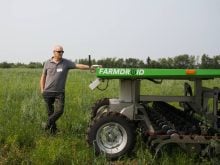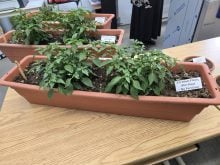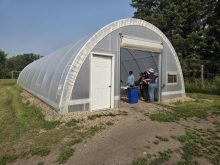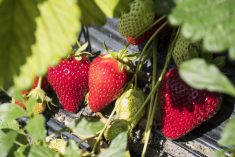At first glance they may look like greenhouses, but aside from growing fruits and vegetables, the similarities between high tunnels and greenhouses pretty much end there.
Popular in produce-growing areas of the northern United States such as Minnesota, high tunnels are slowly making their way onto Manitoba fruit and vegetable operations. Much of that interest came from Manitoba Agriculture’s efforts to identify practices that maximize the benefits of these semi-permanent structures.
WHY IT MATTERS: Indoor vegetable production doesn’t have the same mark on Manitoba’s agricultural sector as in some other provinces, but there are companies making a go of it in the Keystone Province.
Read Also
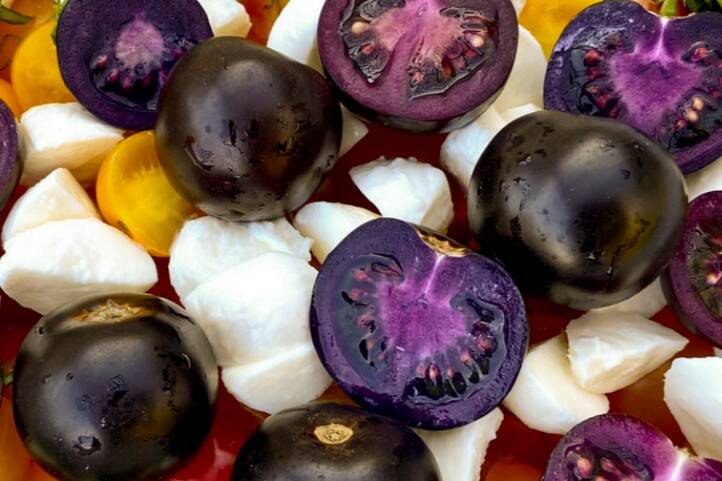
Introducing the purple tomato
Health Canada has approved bioengineered The Purple Tomato (TM), maybe leading to new culinary uses and health benefits?
Under the lead of Tom Gonsalves, a vegetable specialist with Manitoba Ag, researchers have been conducting a series of tests since 2014 to see what grows best in its own built-from-scratch high tunnel in Portage la Prairie.
So far, tomatoes, peppers, cucumbers and spinach have proven their hardiness under its arched frame.
Perhaps their most crucial feature is the ability to extend vegetable farmers’ growing seasons, said Gonsalves.
“If we’re comparing it to field production, you’re going to get in a couple of weeks earlier and depending on how hard the frost is in the fall and how soon it comes, you’re going to get anywhere from a few days at a minimum to probably a number of weeks (in the fall).”
Tomatoes are among the plants that fare best in the tunnel. “We’ve shown you can generate higher marketable yields from tomatoes in a high tunnel versus field production. We have data to back up that statement.”
Gonsalves explained some differences between greenhouses and high tunnels.
First, a greenhouse is a permanent structure grounded by a permanent foundation. They’re usually equipped with electricity, permanent heat and ventilation systems plus glass or plastic covering. They can be used year-round “if you’re prepared to pay the heating bill,” he said.
Meanwhile, a high tunnel is a semi-permanent structure set up on the soil. A standard high tunnel is made of large metal hoops covered by polyethylene plastic. They range in size from 10 to 30 feet wide, nine to 12 feet high and 96 to 100 feet long, according to the University of Missouri-Columbia.
Most high tunnel operators plant right into the soil. In greenhouses, crops are grown in either pots or containers with soil.
“(It) doesn’t have the same degree of engineering required (as a greenhouse),” said Gonsalves.
“In our world here in Manitoba, most municipalities wouldn’t require an engineering certificate to put up a high tunnel, whereas if you’re building a greenhouse, being basically a building, you would require some municipal approvals.”
A greenhouse can be covered in glass or plastic, but glass is generally too rigid for high tunnels.
“One of the purposes of a high tunnel is that it’s cheaper to build than a greenhouse. As soon as you start using a more rigid frame with glass in there, if the frame shifts it’s going to crack the glass,” says Gonsalves.
There’s no permanent heat or powered, forced-fan ventilation in a high tunnel, but temporary heaters can augment heat if necessary. Controlling heat and ventilation in a high tunnel is often done the old-fashioned way: rolling up the sides and opening and closing doors.
Gonsalves and Bruce Berry, a vegetable grower with Almost Urban Vegetables in St. Norbert, Man., identified some of the pros and cons of vegetable producers using high tunnels:
Pro: They extend the season
Gonsalves said one drawback of high tunnels is that it costs more to produce crops versus a field, but that can be offset by the longer seasons they enable.
“Your gain is you get a longer season which gives you more marketable yield and a longer window to sell your crop.”
The high tunnel in Portage averages a one- to four-week extension in the spring and one to three extra weeks in the fall. Although not temperature-controlled, Gonsalves says it offers the growing produce an extra three to five degrees Celsius in borderline freezing temperatures.
“If we go through October where the lowest temperature is, say, minus two or three, we have no death in our high tunnel due to frost.”
However, if there’s an extended period of cold temperatures in, for example, late September, that can quickly lead to a large amount of plant death from frost, putting the producer “behind the eight-ball” for harvesting, says Gonsalves.
That’s when some economic decisions — such as whether or not to continue investing labour in the crop — will likely have to be made.
Berry has found some workarounds to frost, including interplanting tactics such as seeding hardier vegetables such as lettuce earlier than more frost-vulnerable crops.
“(The lettuce will) be out by the time that the tomatoes start really growing tall and shading them.”
Pro: They can be profitable
“We’ve shown with a number of crops … that we can get probably $5,000 to $9,000 income (per year) out of our tunnel,” Gonsalves said. “That varies on the crop you choose and varies on the price in a given year.”
This profitability allowed Manitoba Agriculture to pay the investment off in around two to three years, he says.
“I would challenge any business person to come to me, or come to anyone, with a business plan that shows their capital costs can be paid off in two to three years .”
Pro: They’re flexible
The sheer number of vegetables Manitoba Agriculture has proven high tunnel-worthy is a testament to their flexibility, said Gonsalves.
In addition to the vegetable crops proven to be successfully grown in a high tunnel, the researchers have also evaluated kale, Swiss chard and leaf and romaine lettuce. However, Gonsalves said there’s still more work to be done to gain significant data on that group.
Berry’s seasonal high tunnel crops include tomatoes and cucumbers, but he’s also successfully grown okra. He has three kinds of tunnels — high, mid and low — that are used based on specific crop needs. High-growing vegetables, for example, are usually reserved for the high tunnel.
“We’ve done eggplant in (the high tunnel), but then we realized we could do the eggplant in the mid tunnel. Same with peppers. We realized, ‘Oh, they don’t get very tall — we can do those in the mid tunnel.’”
Con: They can be pricey
Although high tunnels can be profitable and not as expensive as a greenhouse, the initial investment can be heavy. High tunnel kits are generally sold for $10,000 to $12,000, said Gonsalves, although Manitoba Ag was able to build its own for around half the price.
And just like vegetable production can be more labour-intensive compared to grain cropping, high tunnels can further increase labour costs due to a lack of mechanization, he says.
However, a little know-how and experimentation can cut the cost of a high tunnel by some measure.
Berry built one out of a garage shelter — a temporary, portable structure usually used to protect parked vehicles from the elements — on his farm. These tend to retail for hundreds of dollars compared to the thousands asked for high tunnel kits.
“(They have) a very light-duty frame with a tarp over them. And so we just said, ‘Well, we put clear poly over that and it’ll be a high tunnel. And so we did and that worked quite well.’”
A used greenhouse frame can also serve as a high tunnel frame, said Berry. But the most important consideration takes place before the structure is ever placed on the soil.
“Get the soil built up the way you like it before you put the tunnel on top. It’s hard to do that after. That’s obvious, I guess, but maybe not.”
High tunnel users need to identify their goals around these structures and recognize the management practices that drive optimum results, he adds.
“If you make really early produce with it, do you have a place to sell that early produce? And can you make enough to make it worthwhile? You have to understand, I guess, what your goals are with it.”
Con: They can be high maintenance
Berry also said high tunnels can be a nuisance to maintain.
“You’ve got more to do to look after this thing. The poly only lasts four years and then if it gets degraded, it might just rip off from the wind. So you can have maintenance there.”
They can also be a vector for soil salinity if not managed correctly. Berry says leaving the cover on all winter can create salinity leading into a dry spring.
“There’s so much evaporation because it’s hotter. And with no rain, if you’re not careful, you can get salinity building in it. Whereas in an open field, the rain is going to sort of wash those salts back down.”





